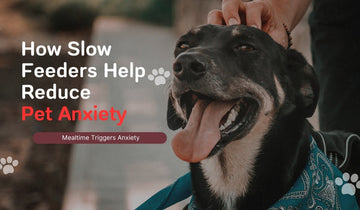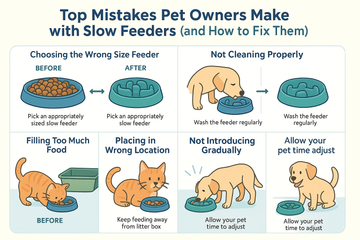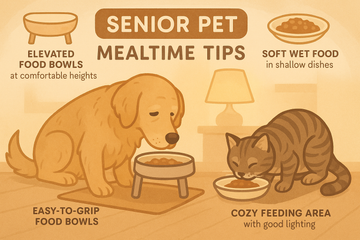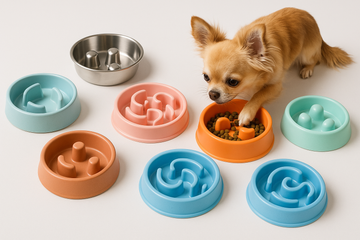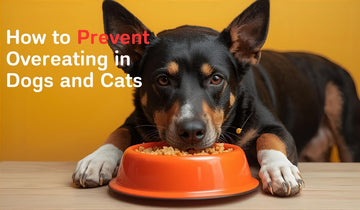For many households, mealtime is the noisiest part of the day—pacing, whining, bowl-slamming, and then… gulping. That pattern is more than a nuisance; it’s a stress loop. The fix isn’t just “less food” or “more training”—it’s redesigning the experience. A well-chosen slow feeder transforms eating from a frantic event into a predictable, soothing routine that supports digestion and the nervous system.
Below, we explain the calming mechanisms behind slow feeders, how to implement them for maximum benefit, and a simple 14-day plan to create truly stress-free mealtime pets.

Why Mealtime Triggers Anxiety (and How Slowing Helps)
Anxious pets anticipate food with arousal—think dilated pupils, rapid breathing, vocalizing. When the meal finally drops, fast eating compounds stress: more swallowed air, gastrointestinal discomfort, and a spiky “high → crash” energy curve.
Slow feeders reduce that spike in three ways:
-
Pacing & Predictability – Obstacles enforce smaller bites and longer chewing/licking, which many pets find naturally soothing.
-
Foraging & Problem-Solving – Gentle challenges tap into instinctive behaviors (sniff, search, paw), giving the brain a constructive job.
-
Choice & Control – Allowing pets to “work” for food (without frustration) offers a sense of agency—key in many dog anxiety solutions.
Quick insight: Licking and steady sniffing are rhythmic behaviors that often help animals self-regulate. Slow feeders and lick mats encourage both.
How Slow Feeders Deliver Calming Benefits
-
Lick-Based Calm: Lick mats spread soft foods thinly, prolonging intake and promoting steady breathing.
-
Maze-Based Focus: Ridge/spiral bowls break up mouthfuls, reducing gulping and post-meal burps.
-
Scatter & Snuffle: Distributing kibble across shallow puzzles or snuffle surfaces turns mealtime into a structured “hunt,” which channels anxious energy.
-
Posture & Comfort: Slight elevation and a stable, heavy best cat bowl or dog bowl can reduce neck strain and bowl-chasing noise—both subtle stressors.

Building a Calm Mealtime Routine (5 Steps)
-
Pre-Meal Reset (2–5 min): A short sniff walk or 60 seconds of “sit—down—place” cues lowers arousal before food appears.
-
Station Confidence: Feed in a quiet, consistent location; add a non-slip mat. Predictability reduces scanning and vigilance.
-
Right Tool for the Job:
-
Wet foods: Lick mats or shallow puzzle plates
-
Dry foods: Maze/spiral slow feeders or treat balls (easy setting first)
-
-
Gradual Difficulty: Start with larger channels and partial portions; progress to full meals or layered/frozen textures.
-
Timed Session: 10–20 minutes is ideal. Pick up leftovers, praise calmly, and end on a relaxed note.
Choosing the Right Slow Feeder (Without Trial-and-Error Headaches)
Material & Hygiene:
-
Ceramic (glazed, lead-free): Non-porous, heavy (stable), easy to sanitize—great for anxious, bowl-pushing pets.
-
Stainless Steel: Durable and dishwasher-safe; add a silicone base to keep things quiet.
-
Avoid scratched plastic that can harbor bacteria and odors.
Design & Fit:
-
Dogs: Match maze depth to muzzle; brachycephalic breeds need shallow patterns. Consider light elevation for comfort.
-
Cats: Choose whisker-friendly, wide, shallow designs; many benefit from a low elevation to maintain a neutral neck angle.
-
Noise Sensitivity: Heavier bowls (ceramic) + anti-slip mats reduce clatter that can trigger anxious pets.

Explore curated, whisker-friendly and heavy-base options at Noka&Aurorastone.
The 14-Day Calm Mealtime Plan
Days 1–3: Foundation
-
Pre-meal sniff/play 2 minutes.
-
Offer 50% of the normal portion on a simple slow feeder (wide channels).
-
Praise soft and low; end session at 10–12 minutes.
Days 4–7: Engagement
-
Increase to 75–100% portion.
-
Add texture layering (e.g., a thin swipe of pumpkin or wet food beneath kibble).
-
For cats, pair half the meal with a lick mat; for dogs, mix 70% bowl + 30% scatter/snout work.
Days 8–11: Progression
-
Introduce slightly tighter maze or a puzzle plate with easy sliders.
-
Trial mild elevation for comfort (especially seniors).
-
Keep sessions within 15–20 minutes; watch for calm body language (looser tail, quiet mouth).
Days 12–14: Personalization
-
Rotate formats (maze → lick mat → snuffle) to keep interest high without raising arousal.
-
Adjust portion placement so “wins” come early, harder bits later—avoids frustration.
-
Log any GI improvements (less burping, fewer hiccups, reduced post-meal pacing).
Troubleshooting Common Anxiety Hurdles
-
Gives Up Quickly: Reduce difficulty; use higher-value toppers (sardine water for cats, a teaspoon of kefir for dogs); keep the first 3 minutes easy.
-
Still Gulping: Try a deeper channel pattern or split the meal into two smaller sessions 30–60 minutes apart.
-
Guarding/Food Tension: Feed in separate rooms; avoid hover-watching. Calm exits and entries only.
-
GI Upset: Slow feeding helps functional issues, but persistent vomiting, diarrhea, or weight loss needs a vet consult.

Beyond the Bowl: Complementary Calming Add-Ons
-
Pre-meal decompression: Sniff walks, nose-work games, or short training.
-
Environment: White noise or soft music; non-slip feeding station; good lighting.
-
Consistency: Same schedule, same place. Anxious pets thrive on structure.
Quick Picks (Calm Kit)
-
Lick mat + shallow maze for gentle slow-feeding
-
Heavier ceramic bowl for stability and less noise
-
Slightly elevated stand for comfortable posture
-
Silicone base mat to define the feeding “zone”
Build your calm-mealtime kit at Noka&Aurorastone—premium ceramic slow feeders, whisker-friendly cat designs, and elevated options chosen to support anxiety relief for dogs and cats.
FAQ
Q1: Do slow feeders actually help with anxiety?
Yes—by promoting licking/foraging, reducing gulping, and adding predictability, they support calmer mealtimes and better digestion.
Q2: Dog panics when the bowl hits the floor—what now?
Use a heavy ceramic bowl on a silicone mat; place it down gently; train a brief “place” cue before release.
Q3: Cat stress-eats and vomits—maze or lick mat?
Start with a lick mat for soft food (soothing, slower), then introduce a shallow maze for dry portions.
Q4: How fast should I increase difficulty?
If body language stays loose and your pet finishes within 10–20 minutes without frustration, step up one notch every 3–4 days.
Turn Frenzy into a Ritual
Slow feeders are a small change with outsized impact—an elegant, practical path to slow feeder calming and truly stress-free mealtime pets.
👉 Shop Slow Feeders & Elevated Bowls at Noka&Aurorastone and start your 14-day calm plan today.

